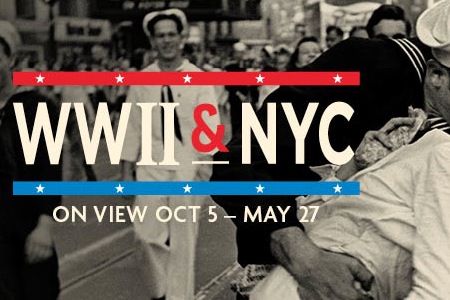The N-YHS Takes a Look at the Big Apple in World War II

WWII & NYC
New-York Historical Society
170 Central Park West
New York, N.Y.
It was inevitable that the greatest war the world has ever known left an indelible mark on the world's greatest city. The New-York Historical Society's new exhibit, "WWII & NYC," covering the better part of three floors, tells the story of how America’s largest city weathered the greatest war of our time.
Visitors learn much about the city’s role in the war and how the most mundane of locations became key centers for research and training. Curator Marci Reaven has done a fine job of developing an entertaining and engaging exhibition that is also very educational.
Part one covers pre-war New York, a time in which most Americans had no interest in becoming involved in the war already raging in Europe. It was also the time of the German Bund, the pro-Nazi German American organzation headed by Fritz Kuhn. In the pre-war area, there is a photo of Camp Siegfried on Long Island, where the Bund held rallies and picnics in the late 1930s. But there's also the anti-isolationist cartoons drawn by Dr. Theodor Seuss Geisel, who later gained fame for his Dr. Seuss books, and sections on pro-Jewish and Russian war relief efforts, plus posters for pro-China war rallies.
What struck me about the exhibit was the effort to remind Americans today not just of the military side of the war, but the way that it underscored the inequality of the races in America and the country’s attitude towards Jews in Europe and here in America. There are dozens of posters extolling the “Double Victory” drive to integrate America at the same time black and white troops fought in a segregated army to liberate Europe. There are numerous items deploring the Nazis treatment of the Jews.
The sections on the city during the war itself are fascinating. In 1944 alone, there were 439 convoys consisting of over 7,000 ships and tens of thousands of troops. That same year, New York handled 50 percent more ship traffic than all other U.S. ports combined. Workers also monitored German U-Boats, which managed to sink 104 ships in the New York area during the war.
Even Rockefeller Center, so well-known for its ice rink and Radio City Music Hall, was the secret headquarters for the Office of Strategic Services (OSS), the forerunner of the CIA.
There are examples of wartime products from New York -- carbines, rifles Maidenform bras, penicillin, Steinway & Sons (the piano wizards) airplane glider wings. The Historical Society itself was turned over to the Red Cross and they used it to supervise thousands of women volunteers who made 4” by 8” surgical bandages. The women turned out four million of them. The Pièce de résistance is the huge brass cyclotron, an atom smasher that was part of the Manhattan Project.
The city was home to thousands of WAVES (Women Accepted for Volunteer Emergency Service), who trained at Hunter College in the Bronx (now Lehman College). Over 80,000 WAVES trained there. The graduates then replaced the men needed for combat. They did everything from fix jeep engines to fly airplanes and remain a heroic and largely unexplored part of U.S. history. Nancy Castellano, a former WAVE, explained in a video oral history what the WAVES did and how quickly they learned how to do it. “The girls loved living in New York, too,” she said. “They did not mind a four- or five-day troop train ride to get here -- it was worth it.”
There are a multitude of segments on entertainment in New York. Even some of the poshest, toniest clubs in New York -- think the Copacabana and the Stork Club -- allowed soldiers and sailors in at no charge. Movie stars were in New York to serve drinks at clubs or work at stage door canteens run by the USO. Traveler’s Aid also ran service centers for GIs.
The single most impressive part of the exhibit is a fifteen minute long strip of home movies by New York native son Francis Lee. Lee became a motion-picture photographer. He carried his camera everywhere and took hours and hours of home movies. Some of them are on display here. He has sensational photos of the D-Day invasion and the liberation of Paris.
The Historical Society will host a World War II film festival with feature films such as Mrs. Miniver, I Was a Male War Bride, On the Town, From Here to Eternity and the documentary Double Victory, that focuses on the all-black Tuskegee airmen. In addition, there will be lectures and panel discussions throughout the year.
The exhibit runs through April.
